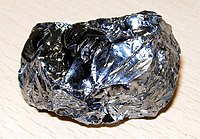
Photo from wikipedia
Genetically engineered silk-elastin-like-proteins (SELPs) synthesized with the combination of silk and elastin domains were bioengineered to also contain a graphene oxide binding domain. The conductivity and mechanical stability of graphene,… Click to show full abstract
Genetically engineered silk-elastin-like-proteins (SELPs) synthesized with the combination of silk and elastin domains were bioengineered to also contain a graphene oxide binding domain. The conductivity and mechanical stability of graphene, combined with SELP-specific graphene interfaces were pursued as dynamic hybrid materials, towards biomaterial-based electronic switches. The resulting bioengineered proteins with added graphene oxide demonstrated cytocompatibility and conductivity that could be modulated by changing hydrogel size in response to temperature due to the SELP chemistry. Upon increased temperature, the gels coalesce and contract, providing sufficient condensed spacing to facilitate conductivity via the graphene domains, a feature that is lost at lower temperatures with the more expanded hydrogels. This thermally induced contraction-expansion is reversible and cyclable, providing an "on-off" conductive switch driven by temperature-driven hydrogel shape-change. This article is protected by copyright. All rights reserved.
Journal Title: Macromolecular bioscience
Year Published: 2022
Link to full text (if available)
Share on Social Media: Sign Up to like & get
recommendations!